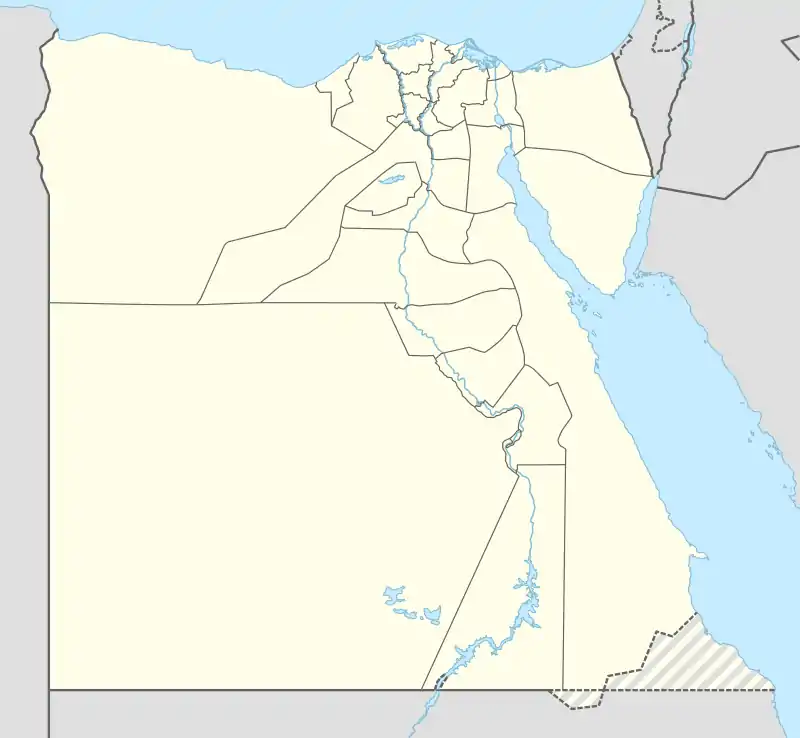31°8′32″N 30°38′42″E / 31.14222°N 30.64500°E
Desouk
دسوق | |
|---|---|
 Clockwise, from top: Desouk Bridge, Ibrahim El Desouki Mosque, City Hall, Nile in Desouk, a statue of Ramesses II with Goddess Sekhmet, Desouk War Memorial, New Desouk Bridge. | |
 Map of Desouk | |
 Desouk Location in Egypt | |
| Coordinates: 31°8′32″N 30°38′42″E / 31.14222°N 30.64500°E | |
| Country | |
| Governorate | Kafr El Sheikh |
| Area | |
| • Total | 8.635 km2 (3.334 sq mi) |
| Elevation | 0 m (0 ft) |
| Population (2021)[1] | |
| • Total | 149,291 |
| • Density | 17,000/km2 (45,000/sq mi) |
| Time zone | UTC+2 (EST) |
| ZIP code | |
| Area code | +2 047 |
Desouk (Arabic: دسوق, Egyptian Arabic pronunciation: [dɪˈsuːʔ]) is a city in northern Egypt. Located 80 km east of Alexandria, in the Kafr El Sheikh Governorate and had a population of 137,660 inhabitants as of 2011.[4] It is bordered to the west by the Beheira Governorate.
Desouk dates back to at least c. 3200 BC and was part of the ancient city of Buto before the unification of Upper and Lower Egypt. From 1250 to 1517, the city of Desouk was part of the Gharbia province. From 1798 to 1801, it was part of the now-defunct Rosetta province.
Etymology
The city's name could be derived from Ancient Egyptian: tꜣ-sbk, lit. 'land of Sobek', attested on a statuette from Sais dating to the Third Intermediate Period, through Coptic: *ⲧⲉⲥⲟⲩⲭⲓ, or from Ancient Egyptian: tꜣ-ı͗ꜣ.t-sbk, attested in Greek as Thasoukhios (Ancient Greek: Θασουχιος) and Tasoukis (Ancient Greek: Τασουκις). The cult of Sobek had presence to the west of Disuq, on the other side of the Nile.
Other proposal derives it from the rare Arabic verb dasaqa "to overflow (about a basin)" and its nominal form daysaq "bassin full of water" which in turn has its origin in Ancient Greek: δίσκος, lit. 'disk, salver', but it is considered implausible. Another improbable etymology is a Copto-Arabic word combining the Coptic feminine definite article ti- (Coptic: ϯ-) with Arabic: سوق, romanized: suq, lit. 'market'.[5]
Overview

Desouk is a member of the Organization of Islamic Capitals and Cities[6] due to the location of important Islamic shrines in the city, such as the tomb of Egyptian Sufi Saint Ibrahim El Desouki, which is located in the main mosque in the center of Desouk.
Desouk lies on the Nile, on the eastern banks of the Rosetta branch, where there are only two bridges entering the city.
Many important Egyptians hail from Desouk: Youssef El-Mansy, Ahmed Zewail,[7] Mohammed Roshdy, Evelyn Ashamallah, and Abdel-Salam Mohammed Nasar, a politician in the city.
-English.JPG.webp)
Climate
Köppen-Geiger climate classification system classifies its climate as hot desert (BWh), the same as the rest of Egypt.
| Climate data for Desouk | |||||||||||||
|---|---|---|---|---|---|---|---|---|---|---|---|---|---|
| Month | Jan | Feb | Mar | Apr | May | Jun | Jul | Aug | Sep | Oct | Nov | Dec | Year |
| Mean daily maximum °C (°F) | 17.8 (64.0) |
18.8 (65.8) |
21.5 (70.7) |
25.3 (77.5) |
29.2 (84.6) |
30.9 (87.6) |
32.2 (90.0) |
32.3 (90.1) |
30.6 (87.1) |
28.8 (83.8) |
24.6 (76.3) |
19.9 (67.8) |
26.0 (78.8) |
| Daily mean °C (°F) | 12.4 (54.3) |
13.1 (55.6) |
15.4 (59.7) |
18.6 (65.5) |
22.3 (72.1) |
24.6 (76.3) |
26.1 (79.0) |
26.2 (79.2) |
24.7 (76.5) |
22.8 (73.0) |
19.1 (66.4) |
14.5 (58.1) |
20.0 (68.0) |
| Mean daily minimum °C (°F) | 7 (45) |
7.4 (45.3) |
9.3 (48.7) |
11.9 (53.4) |
15.4 (59.7) |
18.4 (65.1) |
20.1 (68.2) |
20.2 (68.4) |
18.8 (65.8) |
16.8 (62.2) |
13.6 (56.5) |
9.1 (48.4) |
14.0 (57.2) |
| Average precipitation mm (inches) | 26 (1.0) |
20 (0.8) |
9 (0.4) |
4 (0.2) |
3 (0.1) |
0 (0) |
0 (0) |
0 (0) |
0 (0) |
6 (0.2) |
13 (0.5) |
23 (0.9) |
104 (4.1) |
| Source: Climate-Data.org[8] | |||||||||||||
Notable people
- Mohsen Hendawy (born 1981), Egyptian footballer
See also
References
- 1 2 3 "Disūq (Kism (fully urban), Egypt) - Population Statistics, Charts, Map and Location". citypopulation.de. Retrieved 13 June 2023.
- ↑ "ZIP code, Desouk (1)". Epcodes.com. Retrieved 28 December 2010.
- ↑ "ZIP code, Desouk (2)". Epcodes.com. Retrieved 28 December 2010.
- ↑ "Presidency of Desouk City, Administrative division & Population (2011)". Epcodes.com. 31 December 2009. Archived from the original on 13 November 2010. Retrieved 29 December 2010.
- ↑ Engsheden, Âke (15 August 2023). Ancient Place-Names in the Governorate of Kafr el-Sheikh. Peeters. pp. 133–134. ISBN 9789042941755.
- ↑ "Organization of Islamic Capitals and Cities, Membership". oicc.org. Retrieved 29 December 2010.
- ↑ "Egyptian figures, Ahmed H. Zewail". sis.gov.eg. Archived from the original on 16 October 2010. Retrieved 28 December 2010.
- ↑ "Climate: Disuq - Climate graph, Temperature graph, Climate table". Climate-Data.org. Retrieved 14 August 2013.
External links
- The official site of Presidency of Desouk City (Arabic)
- The official site of Kafr el-Sheikh Governorate (Arabic, English)
- The official site of Desouk City in Kafr el-Sheikh Governorate (Arabic, English)